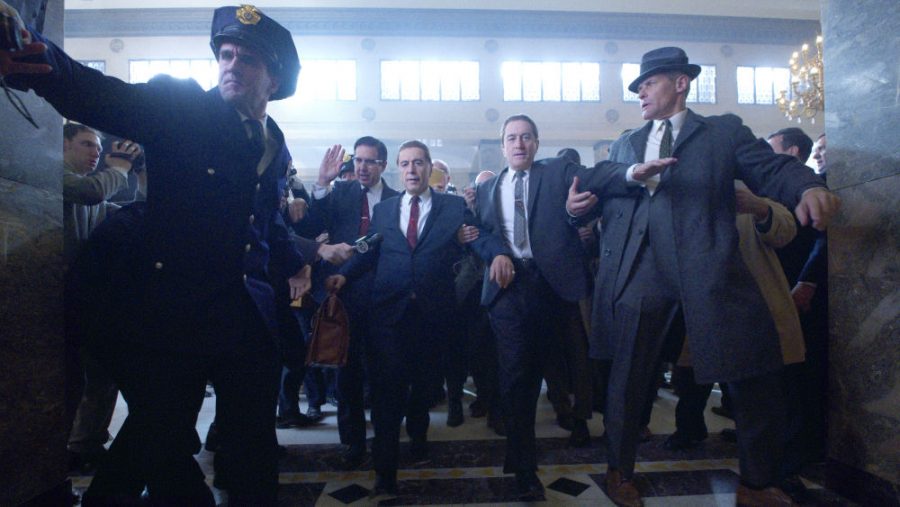Opinion: ‘The Irishman’ is a mob epic about regret, power and accepting mortality
November 27, 2019
In “The Irishman,” director Martin Scorsese has crafted both a tale about about accepting death and one’s own wrongdoings and a gangster movie about the quest for power and the pitfalls of ambition.
It is a slow-burning, poignant look at the end of life through the eyes of detestable people, and Scorsese — now more than 50 years into his career — has given us some of his best work ever and one of the best films of 2019.
The film follows Frank Sheeran (Robert De Niro), a Philadelphia truck driver turned hitman whose life spirals away from him after becoming involved with Russell Bufalino (Joe Pesci), the head of the Bufalino crime family, and Jimmy Hoffa (Al Pacino), America’s biggest and most corrupt union leader at the time.
Based on Sheeran’s much disputed memoir “I Heard You Paint Houses,” we’re taken through multiple decades spanning the mid-20th century as he bears witness to the horrific acts he’s committed.
“The Irishman” is a haul at three-and-a-half hours long, but its massive runtime works to make the audience feel like they’ve lived through half a lifetime with Frank Sheeran by the time the credits roll. Fast-paced storytelling here would be counterintuitive to everything the film is trying to accomplish.
The film opens with a tracking shot in a nursing home almost identical with the famous Copa Shot in “Goodfellas,” Scorsese’s nearly 30-year-old mobster classic.
This couldn’t be more purposeful (or ironic), as in one take the Copa Shot epitomizes everything the protagonist in “Goodfellas,” Henry Hill, has worked to earn, while “The Irishman” quickly establishes everything Frank Sheeran has lost in the exact same manner, moving the camera all around the facility before finally settling on Frank alone in a wheelchair, rendered useless.
Scorsese has made numerous cautionary tales about criminals, but never before has he let the consequences of their actions play out for so long. Frank’s mistakes continue to haunt him long after most movies would’ve ended.
“The Irishman” contains elements present in most gangster movies, like shootings from point-blank range and long conversations in elegant restaurants, but it also centers around its main character contemplating his own mortality and agonizing over long-lasting regrets.
The acting in “The Irishman” is what makes it really come alive, though, which is just an effect of having three of the best actors of all time in one film. De Niro, Pesci and Pacino all give their best performance this century, each unique in its own way.
De Niro’s Frank Sheeran is proud, hesitant and aggressive all at once, never hiding his feelings or keeping those around him guessing. At one point Frank is literally isolated in a corner mourning both the loss of his past life and the life he never had, and his face reveals more pain than any dialogue could.
It’s a dynamic performance capturing practically every emotion in a way which is not once showy or pretentious.
Pesci, usually known for playing the loudest guy in the room, gives a performance subverting all expectations as Russell Bufalino, a subdued, methodical mob boss who introduces Frank to the world of organized crime.
He carries the aura of a mentor and the most dangerous man in their organization solely based on the influence he wields, and it’s reflected in his deliberate, cold-blooded delivery of every line.
Pacino is simply on fire the entire time as Jimmy Hoffa, offering up most of the film’s comedic relief as he’s allowed to selectively use his tendency to overreact, something that has defined the latter half of his career.
He gradually becomes more delusional as time goes, overestimating his power and failing to acknowledge he has no real purpose at the end of his life — something Frank has tortuously come to grips with.
On a surface level, making a mob movie starring De Niro, Pesci and Pacino looks like the safest bet a filmmaker can place, but the finished product here is full of risks.
These gambles extend beyond the film’s content to its production — CGI is used to de-age its three lead actors (all in their 70s) to varying ages throughout most of the film — and distribution, as it arrived on Netflix after spending just four weeks in select theaters due to Scorsese not being able to secure funding from a major studio.
The legendary director tried for nearly a decade to get the film made before Netflix swooped in with a $150 million budget, with a large chunk of the money going toward the previously mentioned special effects.
The de-aging is mostly effective, but it does take a little time to get adjusted and is most noticeable in the earlier parts of the movie. It improves as the characters age closer to the actors playing them, which, in other words, is to say the less effects needed, the better the actors look.
It may be distracting in the beginning, and no amount of CGI can make men in their 70s actually move like they’re 30 years younger, but it does the job well enough and allows these actors to help tell a story they otherwise wouldn’t have been able to.
Patient viewers will be rewarded if they can make it through “The Irishman” in one sitting. If someone can’t clear out almost four hours of their schedule, then the best thing to do is split the film in two parts by stopping it after the first hour and leaving the remaining 180 minutes for later.
This basically divides the movie before and after Pacino’s arrival. Stopping the movie for an extended period of time once he’s on screen will rob it of all its momentum, as he brings more energy to “The Irishman” than anyone else.
“The Irishman” will undoubtedly compete for Oscars come February (possibly among two other Netflix films, “Marriage Story” and “The Two Popes”), and it could be a landmark in film history for how movies from streaming platforms are viewed in the inner-circles of Hollywood. Or it could be dismissed like “Roma” was last year, as it being a Netflix film cost it the best picture award.
Either way, it represents the continuing shift in the industry and how we watch movies, and it’s significant one of the best American directors of all time — if not the best — released his film this way.
While this is important in the grand scheme of movies, it won’t be crossing anyone’s mind by the time a decrepit Frank Sheeran is on screen silently wishing he had done everything differently.
“Goodfellas” ended with a voiceover from Henry Hill lamenting the fact he’d become “an average nobody” after entering witness protection. It’s safe to say Frank Sheeran would’ve traded everything to have kept that title his whole life.
Grade: A






















